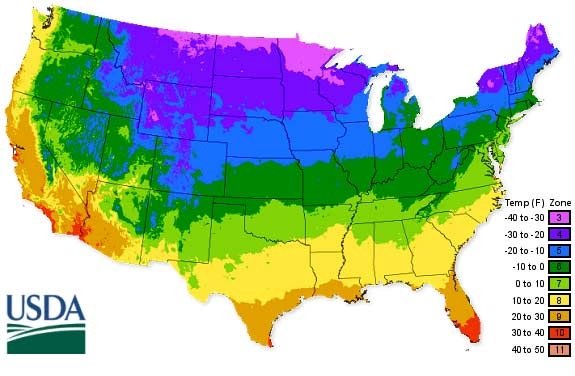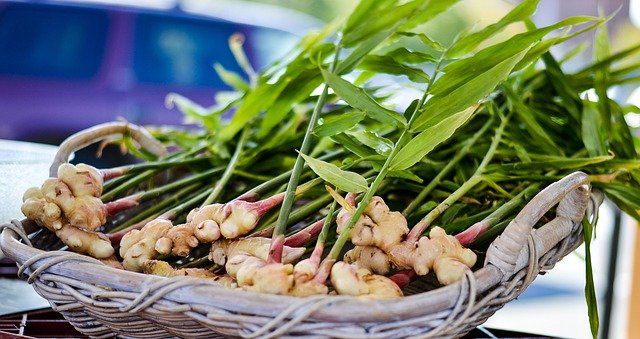Planning to grow ginger in your garden and wondering what can impact a good yield!
There are a few factors for planting ginger such as weather, sunlight, humidity, and temperature that may be out of your hands whereas some other factors like soil, water, and fertilizer can be in your control.
Below are important factors that you should consider before planting ginger in your garden.
Geographic Location: Garden or Containers/Pots
Where should you plant your ginger roots? In pots or in the ground? The answer would depend on the location you live.
Ginger is a tropical plant so suitable for a warmer climate and grows better in higher temperatures of 50℉ and above.
So if you are in the USA, you can answer this question yourself by establishing which Zone you reside in.

You can grow Ginger outside if you are in zone 7 and above as you will find warmer temperatures.
Any zone below 7 is not adequate for growing ginger year-round but you can still grow ginger in these zones in containers using potting mix.
To provide the right temperature, you will have to bring the ginger plant indoors when the winter and frost seasons arrive (as soon as temperatures start to drop below 50℉).
Planting in a container or pot can make the transition indoors fast and seamless.
Soil
Providing all the required care in combination with bad soil is not a winning recipe!
Soil is the first factor that affects the outcome of your ginger plants. Provide the right soil and your ginger plants will have the best chance for good growth.
In soil, there are two main aspects which you should focus on.

1) Nutrients
The soil requirements are similar to those of garlic. It requires calcium and Potassium among other required nutrients.
Ginger adapts well to slightly acidic soil rich in organic matter. The ideal pH value of the soil should be between 5.5 to 6.5.
We understand that everyone’s garden soil cannot be perfect!
If pH is more than 6.5, the soil is more alkaline and if it is lower than 5.5, your soil is more acidic.
You can add manure to make it acidic. Otherwise, if it is too acidic, you can add calcium carbonate or dolomite to get to the right pH levels.
2) Moisture
Ginger requires loose and loamy soil.
The soil should never be waterlogged or wet as these conditions normally always lead to ginger roots rotting. To make sure you avoid any chances of rotting, follow a simple rule. Only water the ginger when the soil is almost dry.
This way you can make sure there is never excess water in the soil but enough to suffice the ginger’s needs.
Fertilizer
Ginger, being a root vegetable is a heavy feeder and fertilizer is mandatory, especially in nutrient-lacking soils. Areas that receive a lot of rainfall may also require additional fertilizer, this is because constant rainfall can leach out important nutrients that are water-soluble.
You can easily identify what category your soil falls in by performing a soil nutrient test prior to planting. Doing this test before planting allows you to improve the quality of your soil by adding compost mix to it or, even a fertilizer (if needed).
When it comes to fertilizing ginger plants, you can use a complete fertilizer or a fertilizer with a higher Phosphorus level since ginger takes more of this nutrient than other plants.
Fertilizing ginger during the growth phase can be done bi-weekly or monthly. Of course, this depends on the needs of the plants and the type of fertilizer that will be applied.
Sunlight
Does your garden get an abundance of sunlight? If so, ginger might not be too thrilled about this. On the other hand, complete shade is not acceptable as well. Your success lies in trying to implement a sunlight pattern similar to that present in the tropics.
Germinating ginger loves heaps of sunshine. It is intense direct sunlight for too long which can create problems for the ginger plants. Ideally, around 2 to 5 hours of intense sunlight and then average to weak sunlight after that is best.
Too much sunlight can sunburn and brown the ginger plant leaves, leaving it weak and vulnerable. Too little sunlight can directly impact the growth of the plant by reducing photosynthesis (food production).
Also when picking the best sunny spot for your ginger roots, make sure the wind is not considerably high as this may also impede growth.
Water
Water is the unit of life for all living things. Any plant will be in danger of shriveling up if water is inadequately provided.
Constant watering throughout ginger growth is vital but you should be aware of the risks of over-watering.
Keep the soil moist. It should neither be waterlogged nor dry.
Too much water can seep into the ground and accumulate at the ginger roots, the exact product you wish to harvest. Sadly, all this water will understandably result in rotting or poor root quality. Waterlogging can be caused by clay-rich soils with poor drainage.
Stay away from these soils, stick to the loamy loose soil. Water the plants with just enough water to soak the soil, and reduce watering efforts as the weather cools and seasons are changing.
Temperature
Ginger is very sensitive to temperature and it is very little you can do to influence the weather. This is why your location matters so much. Some areas are perfect for ginger growing while others make life a bit more difficult for you.
For areas that have tropical temperatures of 50℉ going up, no problem as such is experienced. The addition of mulch will help the ginger roots through the winter season.
But if you live in colder zones, planting in pots is a better solution. This is because the plant will have to be kept indoors if the temperatures drop below 50℉, especially during winter or night.
Humidity
Humidity should not be confused with water content in the soil. Actually, humidity is the amount or percentage of gaseous water present in the air. To stimulate the best ginger root formation, you should have near-tropical conditions in which ginger grows naturally.
Tropical areas receive lots of rainfall. This rainfall in combination with high temperatures causes rapid evaporation of this water. This leads to humid conditions.
Ginger doesn’t grow well in areas of low humidity. Lack of standard humidity could also lead to a reduction in flowers, flowers may cease altogether.
Temperature and humidity go hand in hand and both should be at optimum levels for best Ginger growth.
Tips to Make Sure Your Ginger Grows
Growing ginger for the first time is a new experience, that’s why you need to know about the following factors that can help you succeed in your gardening endeavors.
- Picking the right ginger rhizome is a vital factor in making sure that you harvest large flavorful ginger. Choose the largest, healthiest ginger rhizomes that have numerous ‘eyes” or growth points.
- Soak your ginger overnight just after cutting. This will remove growth retardant chemicals and stimulate or activate the ginger roots.
- Pre-application of fertilizer is advised if you have average to poor quality soil that is lacking in nutrients.
- Constant watering is mandatory, reduce watering as temperatures cool down, this will help to initiate bulb maturation and development.
How do you Trim Ginger leaves?
Trim your ginger leaves if you see yellow or brown leaves or dead flower blossoms. This will help to redirect nutrients back to the area that requires them (roots).
Step 1: Remove Flower Blossoms
Ginger flowers are attractive when in bloom, however, when they die they can create an unappealing sight. Trim these flower blooms by feeling down along the stem and cutting them off from the base of the plant.
Step 2: Trim Old Leaves
Once yellow or brown, leaves will not return to a green color. They still sap energy from the plant and should be trimmed off immediately. Start from the top leaves and work your way down to the bottom-most leaves.
Step 3: Disease Infected leaves
In some cases ginger plant leaves appear to have black or white spots on them, these are usually the first signs of a disease or a pest infestation. Remove them asap to avoid the entire plant becoming infected.


